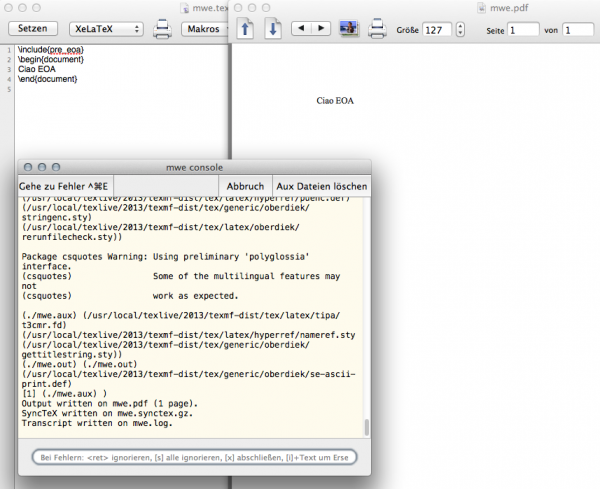User Tools
Sidebar
Table of Contents
A short introduction for authors
The core of our publishing strategy is a canonical format which is currently based on using LaTeX with a restricted number of commands that cover all the necessary features of scientific texts. To fulfill these requirements, it is imperative that certain basic rules are followed so that the authors' texts can easily be converted into the various publishing formats: HTML for viewing the text online, epub for ebook readers, and PDF for printing.
Before continuing we recommend that you download the software, install the recommended packages and work through the sample project. See the links in the sidebar for quick navigation.
Getting started
We are currently supporting the distribution of 2019 which you can download and install from the archive. Furthermore, an editor for editing LaTeX code is required. We recommend using TeXShop on Apple computers and TeXWorks for Windows.
Please note that self-defined LaTeX-Macros are not supported. The special LaTeX commands defined for this system ensure maximum consistency and convertibility. Without this restriction, it would be impossible to convert the publications into ePub and HTML. The list of authorized commands is available on this page, as well as in a separate document.
For a quick start and to check if the LaTeX installation works, download the preamble pre_eoa.tex, start the LaTeX editor and paste the following code into the window:
\include{pre_eoa} \begin{document} Ciao EOA \end{document}
Save that file in the same place where you put the preamble, select XeLaTeX from the second menu to the left and click on “Setzen”. If everything went well, you should see two new windows: the log window and the resulting PDF. You can now start and set up a real project.
Setting up a project
Create a folder on your computer which will contain the data for the whole project. Download the preamble from this site (link top left). The preamble contains all the commands and layout definitions. All TeX files (including BibTeX files) should be placed in this single folder. Illustrations and graphics are best stored jointly in a subfolder called 'Images.'
File and directory names must begin with a letter and not include blanks, umlauts or other special characters (except hyphens and underscores).
The character encoding of the LaTeX file should always be UTF-8. Line breaks should be simple line feeds (LF) as is customary in Unix. This may necessitate a change in the standard settings of the editor.
The cited literature must be entered into a bibliographic database (e.g. BibDesk).
If illustrations and graphics are placed in a subfolder, the path has to be made explicit in the TeX file:
\EOAfigure{Images/Figure_1.png}{Caption}{Label}{99}{ht}
Each project consists of at least three files:
- The
pre_eoa.texfile contains the preferences, macros and packages defined for the purpose of the project and the text file. Generally, the preamble does not need to be changed by the authors. Individual requirements should be discussed with the Development Team. - The
biblio.bibfile exported from the bibliographic database. - The main file containing the text written by the author. In the case of edited books, this file may be divided into individual chapters. In order to generate a complete table of contents, the chapter titles and the names of the authors should be kept in the main file. The chapter files are inserted into the main file with the
\input{…}command.
Each main file begins with the commands
\include{pre_eoa} \EOAbibliographytype{monograph} \EOAbibliographydatabase{biblio} \EOAseries{Proceedings} \begin{document}
The purpose of the first line is to embed the macros and commands that are defined in the preamble. The command \EOAbibliographytype in the second line defines what kind of bibliography is being created. Use {monograph} for one large bibliography at the end of the publication or {anthology} for one bibliography at the end of each chapter. The command \EOAseries may contain one keyword (Studies, Sources, Proceedings or Textbooks). It defines the dimensions of the book and may alter various options. The command \EOAbibliographydatabase refers to the file containing the bibliographic database. In the example above, the command refers to the file biblio.bib.
The main text ends with the command
\end{document}
The title and author of the publication as well as other links like ISBN and frontmatter will be provided by the Edition Open Access Team before publishing.
Prerequisites & Typesetting
In general, the implemented procedure is independent of any computer platform, editor and program. The only prerequisite is that the authors have a basic LaTeX environment installed, which is available for all commonly used operating systems. We use XeLaTeX (which is part of the standard distribution of TeX) instead of pdflatex or latex. This enables us to type Unicode (UTF-8) and avoid the coding of non-ASCII-characters. This applies in particular to non-Latin scripts such as Classical Greek or Chinese. Furthermore, we use BibLaTeX, a complete reimplementation of BibTeX alongside with Biber. This enables us to accurately typeset bibliographies that include non-Latin scripts. All these programs are already included in the current releases and do not have to be downloaded separately.
Please note: This procedure requires the configuration of most editors (such as TeXShop, TeXWorks, BibDesk and JabRef). In general, you must use the command xelatex rather than pdflatex or latex. In addition, the command biber has to be used instead of bibtex. Typesetting the publication therefore requires the following commands:
xelatex Main_TeX_Filebiber Main_TeX_Filexelatex Main_TeX_File
The command makeindex is not used. The index is generated using the package *imakeidx* which is included in the preamble.
The current distribution of TeX (2019) is used for the time being. For Mac and Windows users, this is combined with a convenient working environment that runs on Mac systems OS 10.12 (Sierra) or higher, or Windows Vista and later.


